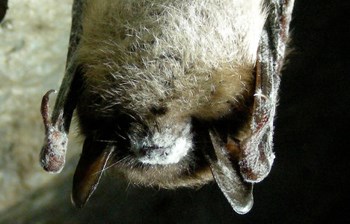
What is White-nose Syndrome? White-nose syndrome (WNS) is a contagious disease that affects populations of hibernating bats. A fungus spreads along the skin of susceptible species causing infected bats to abnormally rouse from their hibernation. This excessive activity uses up fat reserves necessary to survive the winter. With the lack of insects during the hibernation months, bats can easily starve to death. The fungus primarily damages the wings of bats, which in addition to flight, are critical to other physiological functions. Millions of bats in North America have died from WNS since its discovery in 2006. What is Your Role After Visiting Jewel Cave?Humans may transmit the fungal spores on shoes, clothing, or gear worn in caves or mines in affected areas. To prevent the spread of WNS, visitors participating in the Historic Lantern tour will walk across a decontamination mat. Jewel Cave has been identified as a WNS-positive site. For this reason, visitors are advised that other cave sites may not allow them to enter another cave with any item that has been inside Jewel Cave. Furthermore, footwear, clothing, or gear worn in Jewel Cave will NOT be allowed on the Candlelight and Wild Cave Tours at nearby Wind Cave National Park. In addition, do not handle any bats, living or dead. If you come across bats suspected of having white-nose syndrome, contact any nearby wildlife agency. If you have visited caves or mines suspected to contain WNS, follow appropriate decontamination protocols to prevent transmission of the disease. Most importantly, you can increase awareness among your friends and family by talking about white-nose syndrome and the importance of bats.The Importance of BatsThe importance of bats to ecosystems around the world is well established. Many species consume insects that would otherwise affect human health or damage crops and forests. Without bats to control insect populations, farmers would be forced to use more pesticides. This, in turn, would result in an increase in the price of certain foods. It is estimated that by eating insects, bats save the agricultural industry billions of dollars each year. Other bat species are valuable in the pollination of plants and the dispersal of plant seeds. You can also help bats when they are not hibernating by planting moth-attracting wildflower gardens and by installing bat houses to provide additional habitat.Origins of White-nose Syndrome The fungus that causes white-nose syndrome is believed to have originated in Europe or Asia. It has been confirmed that the disease is being spread through bat-to-bat transmission. It is also spread by human activity. The first identified case of WNS in North America was discovered in Schoharie County, New York in February of 2006. Within the first five years of its discovery, white-nose syndrome had spread over 1,200 miles from the original site. The disease is caused by a cold-loving fungus known as Pseudogymnoascus destructans. This fungus thrives in dark, humid and low temperature (40-50 degrees Fahrenheit) environments. Unlike typical fungi, Pseudogymnoascus destructans cannot grow above 68 degrees Fahrenheit, making underground bat hibernacula (caves or mines) ideal for growth of this pathogen. Bat Species Affected by White-nose SyndromeCurrently, white-nose syndrome is impacting seven hibernating species of bats that inhabit higher latitudes of North America. The decimation, or possible extinction, of many hibernating bat populations of North America is possible as many of these species live for five to fifteen years and only produce one off spring per year.There are forty-five species of bats inhabiting the United States; bats represent about 20% of all mammal species in the world. Most bat populations are stable and do not fluctuate widely over time. The little brown bat (Myotislucifugus), the Federally-threatened northern long-eared bat (Myotisseptentrionalis), and the Federally-endangered Indiana bat (Myotissodalis) have been hit particularly hard by WNS. Jewel Cave supports one of the largest known hibernating colonies of Townsend big-eared bats (Corynorhinustownsendii) in the West. Other bat species that live at the monument include:
Learn More About WNSFor more information on white-nose syndrome and the decontamination process prior to visiting caves, please visit www.WhiteNoseSyndrome.org.
|
Last updated: September 24, 2025
